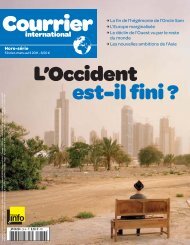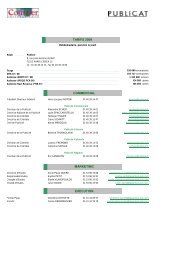2 ОРГАНИЗАЦИЯ И МЕТОДИКА РАБОТ - Courrier international
2 ОРГАНИЗАЦИЯ И МЕТОДИКА РАБОТ - Courrier international
2 ОРГАНИЗАЦИЯ И МЕТОДИКА РАБОТ - Courrier international
Create successful ePaper yourself
Turn your PDF publications into a flip-book with our unique Google optimized e-Paper software.
11.4 Conclusions and recommendations.<br />
Summarizing all the above on the technological project of preservation of objects<br />
containing sovtol and other PCB-containing liquids should draw some conclusions and<br />
recommendations.<br />
Firstly, taking into account the available experimental data on the performance of work, the<br />
most appropriate technology, the elimination of waste liquids and oils, containing PCB, is a<br />
set of interrelated stages, including the steps of: identifying, collecting liquid waste container<br />
and neutralize the liberated stage of immediate elimination (recycling) collected spent oils and<br />
technical liquids.<br />
Second, the neutralization capacity equipment from the PCB, most effectively by way of<br />
neutralizing reagent.<br />
As this method is most appropriate implementation technology with the use of methylene<br />
chloride vapor. Neutralization of the drums and other equipment from residual PCB useful to<br />
carry out reagent method, and spent activated carbon from the site clean exhaust gases<br />
disposed in the installation of high-temperature oxidation.<br />
Thirdly, wood and other combustible waste must be sorted. Waste with high concentrations of<br />
especially dangerous pollutants such as PCB, are due for elimination in high temperature<br />
plants. The remaining unusable wood waste, grind and useful as a fuel or combustible<br />
material to burn a simple to install high-temperature combustion (incinerator) or to install<br />
"Fakel - 1M. Likewise it is recommended to deal with other combustible solid waste,<br />
including rubber and plastic products, paper and cardboard, paper and remnants of clothing<br />
and uniforms, etc. Exceptions should be made of polyvinyl chloride products, which are<br />
burning in the vast majority (not equipped with special systems flue gas) incinerators is<br />
unacceptable. This kind of waste must be burned in the installation of high-temperature<br />
incineration.<br />
Fourthly, it was found that the basic technology of neutralization of hazardous organic<br />
pollutants such as PCB is high temperature oxidation (combustion) with afterburner systems<br />
and neutralization of waste gases.<br />
The process of destroying hazardous wastes is most advisable to implement technologybased,<br />
providing for the use as a node in the thermal cracking of a rotary furnace and a plasma<br />
afterburner, as well as 3-stage flue gas cleaning systems on the basis of complex treatment<br />
technologies and automatic control.<br />
Fifth, the preservation of elements of buildings, brick and wood, chemical control in the past<br />
for safety and are not intended to restore and use for its intended purpose, is not provided -<br />
these objects should be destroyed. Concrete and brick secondary materials should grind up to<br />
the size and gravel used for road bank filling in their accomplishment, as the rubble is in the<br />
manufacture of light weight concrete coatings storage, recreation, other sites etc.<br />
Sixthly, the soil in field work on o.Alexandra Island is a mixture of various size fragments,<br />
mostly of basaltic origin, sand and very small amounts of organic residues. Therefore, oil<br />
pollution is not included in the structure of the soil, but remains in the form of spots and<br />
inclusions in various mineral residues.<br />
FINAL REPORT for Contract No. CS-NPA-Arctic-13/2009 of December 01, 2009 within the framework of pilot project<br />
Development of Technology of clean up of the area of Decommissioned Sites of The Russian Federation Ministry of Defense in<br />
the Arctic by the Example of Alexanra Island of Franz Josef Land Archipelago from Hazardous Waste<br />
198








